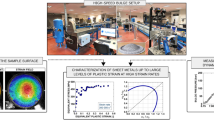Abstract
In this study, a comprehensive mathematical analysis of the bulge test is presented. The geometry of the bulge test and the stress state that prevails in this test are very similar to the expanding thin wall sphere. These similarities may lead many users to confuse the interpretation of incremental change in the radius of the sphere as radial strain and consequently invalid analysis of the instability conditions. Therefore, in this study, emphasis is placed on how to properly use the equations to obtain the strain stress curve by this method precisely. Assuming work hardening behavior to obey power law, based on stress state on the dome, the relationship between fluid pressure and the height of the dome is presented. The instability condition is then determined and compared with Hill's analysis. To confirm the mathematical analysis, the hydraulic machine equipped with a computer system for recording pressure data versus the height of the bulge was used. The bulge test is conducted on two typical sheet metals, copper and commercially pure aluminum. The measured fluid pressure during the deformation and the thickness distribution of the sample well confirmed the results of the analytical analysis.
Graphic Abstract









Similar content being viewed by others
Abbreviations
- \(\sigma_{\theta }\), \(\sigma_{\varphi }\) and \(\sigma_{r}\) :
-
Hoop, meridian, and radial (thickness) stresses
- \(\varepsilon_{\theta }\), \(\varepsilon_{\varphi }\) and \(\varepsilon_{r}\) :
-
Hoop, meridian, and radial (thickness) strains
- \(\varepsilon_{t}\) :
-
The absolute value of thickness strain
- \(\overline{\sigma }\) :
-
Effective stress
- \(\overline{\varepsilon }\) :
-
Effective strain
- \(\overline{\varepsilon }_{{{\text{ins}}}}\) :
-
Effective strain at the onset of instability
- \(e_{\theta }\) :
-
Engineering hoop strain
- h :
-
Height of the dome
- a :
-
Base radius of the dome
- \(\rho\) :
-
The radius of the dome
- z :
-
The current height of any material point
- t 0 and t :
-
The initial and current thickness of the sheet
- n :
-
Work hardening exponent
- k :
-
Coefficient of strength
- p :
-
Oil pressure
References
Barnwal VK, Lee S-Y, Choi J, Kim J-H, Barlat F (2021) On the fracture characteristics of advanced high strength steels during hydraulic bulge test. Int J Mech Sci 190:106032. https://doi.org/10.1016/j.ijmecsci.2020.106032
Cai G, Lang L, Liu K, Alexandrov S, Zhang D, Yang X, Guo C (2015) Research on the effect of flow stress calculation on aluminum alloy sheet deformation behavior based on warm bulging test. Met Mater Int 21(2):365–373. https://doi.org/10.1007/s12540-015-2018-0
Chakrabarty J, Alexander JM (1970) Hydrostatic bulging of circular diaphragms. J Strain Anal 5(3):155–161. https://doi.org/10.1243/03093247v053155
Chen K, Scales M, Kyriakides S (2018) Material hardening of a high ductility aluminum alloy from a bulge test. Int J Mech Sci 138–139:476–488. https://doi.org/10.1016/j.ijmecsci.2018.02.002
Chen K, Scales M, Kyriakides S, Corona E (2016) Effects of anisotropy on material hardening and burst in the bulge test. Int J Solids Struct 82:70–84. https://doi.org/10.1016/j.ijsolstr.2015.12.012
Gamby D, Lampi LH (1984) An approximate numerical method for circular membranes under lateral pressure. J Strain Anal Eng Des 19(4):261–267. https://doi.org/10.1243/03093247v194261
Güner A, Brosius A, Tekkaya AE (2009) Analysis of the hydraulic bulge test with FEA concerning the accuracy of the determined flow curves. Key Eng Mater 410–411:439–447
Gutscher G, Wu H-C, Ngaile G, Altan T (2004) Determination of flow stress for sheet metal forming using the viscous pressure bulge (VPB) test. J Mater Process Technol 146(1):1–7. https://doi.org/10.1016/s0924-0136(03)00838-0
Hill RC (1950) A theory of the plastic bulging of a metal diaphragm by lateral pressure. Lond Edinburgh Dublin Philos Mag J Sci 41(322):1133–1142. https://doi.org/10.1080/14786445008561154
Hosseini ME, Hosseinipour SJ, Jooybari MB (2017) Analysis of void growth during superplastic deformation of commercial AL5083 Alloy. Iran J Sci Technol Trans Mech Eng 42(1):41–49. https://doi.org/10.1007/s40997-017-0075-3
Koç M, Billur E, Cora ÖN (2011) An experimental study on the comparative assessment of hydraulic bulge test analysis methods. Mater Des 32(1):272–281. https://doi.org/10.1016/j.matdes.2010.05.057
Kruglov AA, Enikeev FU, Lutfullin RY (2002) Superplastic forming of a spherical shell out a welded envelope. Mater Sci Eng A 323(1–2):416–426. https://doi.org/10.1016/s0921-5093(01)01376-4
Kular GS, Hillier MJ (1974) Geometry of a bulged diaphragm. J Appl Mech 41(2):524–525. https://doi.org/10.1115/1.3423326
Marandi FA, Jabbari AH, Sedighi M, Hashemi R (2016) An experimental, analytical, and numerical investigation of hydraulic bulge test in two-layer Al–Cu sheets. J Manuf Sci Eng 139(3). https://doi.org/10.1115/1.4034717
Marciniak Z, Duncan JL, Hu SJ (2002) Mechanics of sheet metal forming. Butterworth-Heinemann, Oxford
Mirnia MJ, Vahdani M (2020) Calibration of ductile fracture criterion from shear to equibiaxial tension using hydraulic bulge test. J Mater Process Technol 280:116589. https://doi.org/10.1016/j.jmatprotec.2020.116589
Pham QT, Kim YS (2017) Identification of the plastic deformation characteristics of AL5052-O sheet based on the non-associated flow rule. Met Mater Int 23(2):254–263. https://doi.org/10.1007/s12540-017-6378-5
Slater RAC (1977) Engineering plasticity. London Macmillan Education Uk, pp 165–169
Sun L, Cai Z, Gao J, Wang M, Li L (2021) Calibration of ductile fracture criterion with optimal experiment design and prediction on forming limit for aluminum alloy sheet. Met Mater Int. https://doi.org/10.1007/s12540-021-00970-3
Acknowledgements
The authors appreciate Shiraz University for its financial support (Grant numbers of 99-GR-ENG-15) and research facilities used in this work.
Author information
Authors and Affiliations
Corresponding author
Ethics declarations
Conflict of interest
Conflict of interest on behalf of all authors, the corresponding author states that there is no conflict of interest.
Rights and permissions
About this article
Cite this article
Ebrahimi, R., Lotfabad, F.R. A Comprehensive Mathematical Analysis on Achieving Stress–Strain Behavior at Large Strains in Bulge Test. Iran J Sci Technol Trans Mech Eng 46, 901–909 (2022). https://doi.org/10.1007/s40997-021-00451-3
Received:
Accepted:
Published:
Issue Date:
DOI: https://doi.org/10.1007/s40997-021-00451-3




